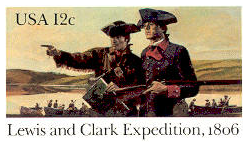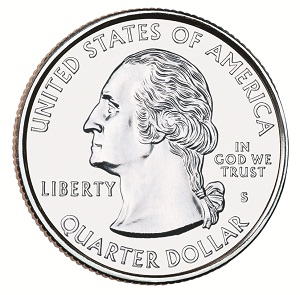
US Postage Stamps
// Philatelic Project
// The Federal States



|
Lewis and Clark Expedition
"Corps of Discovery" (May 14, 1804 - September 23, 1806) |
| In fall 1803 the third US President (1801-1809) Thomas Jefferson (* 1743, † 1826) comissioned his personal secretary US Army Captain Meriwether Lewis (* 1774, † 1809) to assemble an expedition team to explore the northwestern part of the newly acquired area of the Lousiana Purchase on April 30, 1803. Captain Lewis, who appointed his friend US Army Second Lieutenant William Clark (* 1770, † 1838) to his co-commander, concentrated a group of US Army volunteers at Camp Dubois [Camp Wood] for trainig and instruction during fall/winter 1803 and early spring 1804. The military camp was then located in the Indiana Territory, near present-day Wood River, IL, on the east bank of the Mississipi River at the confluence with the Missouri River adjacent to St. Louis, MO. |
| On May 14, 1804 at 4:00 p.m. the "Corps of Discovery", consisting of 33 people led by William Clark, departed from Camp Dubois and met up with Captain Lewis on May 20 in St. Charles, MO, marking the beginning of the voyage to the Pacific coast. The Corps travelled up the Missouri River aboard a 55-foot-long [17 meter] keelboat and two smaller pirogues. |
| On August 20, 1804, Sergeant Charles Floyd (* 1782) died, apparently from acute appendicitis. He was the only member of the Corps to die along the journey. |
| In October/November 1804 the Corps built Fort Mandan, an encampment to spend the winter 1804/1805, approximately twelve miles from present-day Washburn, ND. The fort was named after the Mandan Indian tribe living together with the Hidatsa tribe in that area. |
| On April 7, 1805 the expedition left Fort Mandan and continued its voyage to the Pacific cost. The expedition was accompanied by Toussaint Charbonneau, a French-Canadian fur trapper who lived among the Hidatsa Indians, and his Shoshone wife, Sacagawea, both hired by Lewis as guide and interpreter. |
| On June 13, 1805 the members of the expedition became the first white men to see the Great Falls of the Missouri River, five separate falls on a stretch of 12 miles (19 km). The portage around the falls begun on June 22, and it took more than one month before the expedition reached the next stretch of navigable water. |
| From August 25 to October 07, 1805 the expedition tracked through the Bitterroot Mountains on horseback. The horses could be purchased from the Shoshone Indians with the help of Sacagawea whose brother was the chief of the Shoshone tribe. Once across the Rockies and the Continental Divide, the Corps could travel by canoes on the Clearwater River and the Snake River to the westward-flowing mighty Columbia River. |
| On November 18, 1805 the expedition reached the Pacific Ocean at the mouth of the Columbia River and built Fort Clatsop, approximately 5 miles (8 km) southwest of present-day Astoria, OR, where they planned to spend the winter 1805/1806. Like Fort Mandan the fort was named after the Indian tribe living in that area. |
| On March 22, 1806 the "Corps of Discovery" started with five dugouts the journey back across the continent. The hope to sail back to St. Louis, MO aboard of an offshore anchoring American or British sailing vessel failed. On the return trip, Lewis and Clark decided to split up the Corps to explore more of the Lousiana Territory. Lewis and nine men crossed the Continental Divide on July 3, 1806 and explored the Marias River to the north into the dangerous Blackfeet Indian territory, while Clark and the others crossed the Continental Divide on July 8, 1806 heading south into the Crow Indian territory. |
| On August 11, 1806 the both groups were reunited and headed homewards down the Missouri River. On the morning of September 23, 1806 the "Corps of Discovery" entered the Mississippi River and at noon disembarked at St. Louis, MO - two years, four months, and ten days after they had left. Gathered along the river shore, cheering crowds greeted the returned Corps with gunfire salutes and an enthusiastic welcome. US President Thomas Jefferson claimed the Pacific Northwest, present-day the states of Washington, Oregon, and Idaho for the United States. |
| [Timeline of the Lewis and Clark Expedition] |

|
|
#UX91 // September 23, 1981 // St. Louis, MO
Stamped Postal Card Lewis and Clark Expedition (May 14, 1804 - September 23, 1806) Clark (left) and Lewis (right) charting the course of the Missouri River |

|

|
|
US Mint® // 50-State Quarters® Program // August 4, 2003
(Obverse and reverse design of 25¢ coin) Missouri Reverse design (right): Inscription: "CORPS OF DISCOVERY 1804 - 2004" Lewis and Clark historic expedition (1804-1806) on the Missouri River, Jefferson National Expansion Memorial, Gateway Arch, St. Louis, MO |
|